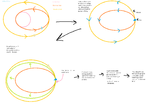Tutorial: Advanced Orbiting
Contents
Hohmann transfer
This is the most frequently used method of changing orbital altitudes while keeping the same inclination. The ending orbit may be around the same celestial body as it began or for travelling to another body, such as between Kerbin and the Mun.
It involves first entering an eccentric orbit, then circularizing once reaching the desired orbital altitude. Thus, there are two burns to be made, ideally using engines with high thrust-to-weight ratios; low TtW can require up to 40% greater Δv from having to start earlier at less efficient points than apoapsis or periapsis are for changing orbits.
To transfer from a lower orbit to higher:
- Burn prograde at periapsis until the apoapsis reaches the desired altitude.
- Upon reaching the raised apoapsis, burn prograde until periapsis rises to the desired altitude.
To transfer from higher to lower:
- Burn retrograde at apoapsis until the periapsis reaches the desired altitude.
- Upon reaching the lowered periasis, burn retrograde until apoapsis falls to the desired altitude.
(See also Hohmann transfer orbit on Wikipedia)
Bi-elliptical transfer
The bi-elliptic transfer can be more efficient (but slower) than the Hohmann transfer orbit in some cases (when going from a very tight orbit to a very large one: the ratio must be higher than ~12:1). This is because changes of speed are more efficient at low speeds (and therefore at high altitudes).
- Start by burning prograde (most efficiently at periapsis) until orbit becomes highly elliptical with the apoapsis higher than starting and desired orbits.
- At apoapsis, burn prograde until the periapsis reaches the altitude of your desired orbit.
- Upon reaching periapsis, burn retrograde until your orbit is circularized.
Opposite burns at these same points will lower your orbit. This can be used to enable aerobraking to lower your orbit height.
Orbital plane alignment
The first step in intercepting another orbiting body is to align your orbital plane with the target's orbital plane.
Next is to find the pivot point on your orbit that, when turned clockwise or counterclockwise (from the perspective of camera > ship > orbited object), will cause it to line up with the other orbit.
Next, find the midpoint between your prograde and retrograde motion on the horizon and point your ship toward it. Throttling prograde + 90 degrees on the horizon will cause your orbit to rotate clockwise. Prograde - 90 degrees on the horizon will rotate the orbit counterclockwise. It may take a few rotation sessions to perfect your orbit but this will allow you to match another orbital plane.
It is easier to achieve if your orbit is circular, mostly because you can line up the orbits in the map view much more easily.
Orbit synchronization
In progress.
The Exley maneuver
(As of version 0.17.1)
Named by its author, wiki user Sir Exley, it is an approach to getting an encounter with a target planet without having a precise launch window planned by entering an eccentric orbit whose apoapsis meets the orbital path of your target and a periapsis whose altitude has a lower altitude around the sun that the target.
In order to easily meet with a target planet's sphere of influence, you will need to perform a few burns while at either the periapsis or apoapsis of your transfer orbit.
Planets outside your original orbit
If you are meeting with a planet whose orbit is outside of your starting orbit, create a transfer orbit such that your apoapsis is as close as possible to your target planet's orbit.
Next, make a few orbits until the target planet is slightly in front of you when you reach your apoapsis. Begin a prograde burn until you see your orbit cross the target planet's near your apoapsis for a fraction of a second. If you overshoot, simply turn around and burn retrograde until the cross orbit is visible again. If your transfer orbit exceeds the planet's orbit, then you have gone too far, and have either missed the cross orbit, or do not have an apoapsis close enough to the target orbit to be affected by the planet's sphere of influence.
Planets inside your original orbit
If you are meeting with a planet whose orbit is inside of your starting orbit, create a transfer orbit such that your periapsis is as close as possible to your target planet's orbit.
Next, make a few orbits until the target planet is slightly behind you when you reach your periapsis. Begin a retrograde burn until you see your orbit cross the target planet's near your periapsis for a fraction of a second. If you overshoot, simply turn around and burn prograde until the cross orbit is visible again. If your transfer orbit goes within the planet's orbit, then you have gone too far, and have either missed the cross orbit, or do not have a periapsis close enough to the target orbit to be affected by the planet's sphere of influence.
Finally
Once you are in the cross orbit, burn retrograde until the orbit goes around your target planet.
Good luck!
